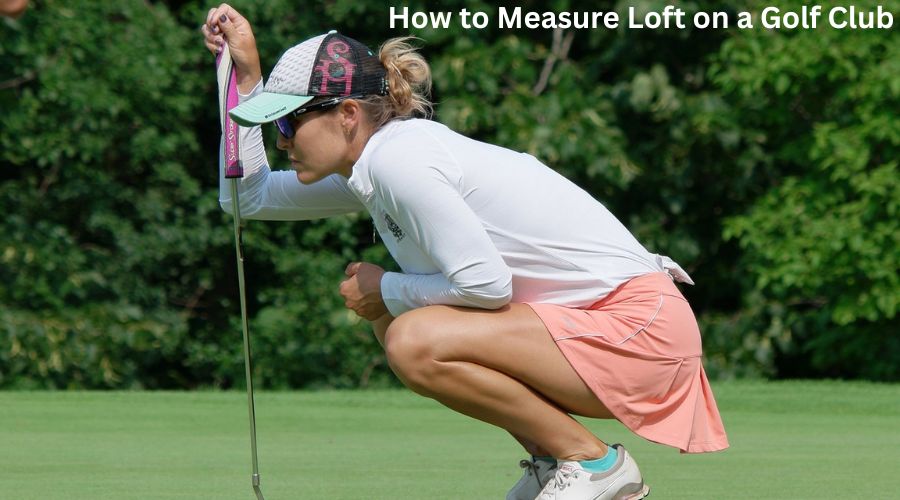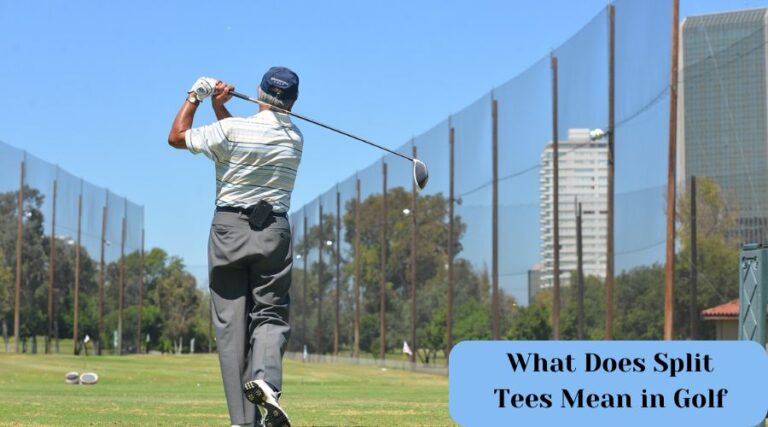To measure the loft on a golf club, use a protractor or a specialized loft gauge. Place the tool against the clubface to read the angle.
Understanding the loft of your golf clubs is essential for optimizing your game. Different clubs are designed with varying loft angles to achieve specific distances and trajectories. Knowing the exact loft helps golfers choose the right club for a particular shot.
This knowledge is particularly useful when customizing a set to match a player’s unique swing style. Accurate loft measurements ensure that your clubs are well-suited to your gameplay, leading to improved performance and consistency on the course. As golf technology advances, players have more tools at their disposal to fine-tune their equipment, making the art of measuring loft an important skill for any serious golfer.
Contents [hide]
Introduction To Loft In Golf
Mastering your golf game begins with understanding the basics, and one essential element is the loft of a golf club. Loft determines the trajectory and distance of your golf ball. Get to grips with the angle of your clubface and see how it can shape your game on the green.
Importance Of Loft For Your Game
The loft of a golf club is key to controlling ball flight. A higher loft means a higher, shorter shot. A lower loft leads to a longer, flatter shot. Know your club’s loft to choose the right club for each shot. This knowledge can improve your accuracy and lower your scores.
- Flight Path: Affects how high and how far the ball goes.
- Distance Control: Helps with precise shots.
- Obstacle Navigation: Clears hazards with ease.
Factors Affecting Loft
Several factors can change the loft of your golf club. It’s not just about the club’s design. Your swing, the club’s wear, and even modifications can alter the loft. Be aware of these factors to maintain consistency in your game.
| Factor | Impact on Loft |
|---|---|
| Club Wear | Changes loft over time. |
| Swing Mechanics | Influences dynamic loft. |
| Adjustments | Custom loft settings. |
Essential Tools For Measuring Loft
Knowing the correct loft on your golf club can greatly enhance your game. Essential tools help measure loft accurately. Let’s explore some options.
Loft Measuring Devices
Specialized loft measuring devices are ideal for precision. These tools are designed for golf clubs. They provide exact loft angles quickly. Here are top devices:
- Golf Loft Gauges: These gauges fit various club types.
- Digital Inclinometers: They show angles on a digital screen.
Protractor And Other Alternatives
Not ready to invest in specialized tools? No problem! A simple protractor can work. Here’s how to use it:
- Place the protractor on the clubface.
- Read the angle shown. This is the loft.
Other tools include:
- Smartphone apps: Many apps offer angle measurements.
- Rulers and Angle Finders: They help estimate the loft.
Preparing Your Golf Club
Knowing the loft of your golf club is crucial for improving your game. Before you measure the loft, ensure your club is ready. A clean club head and a secure setup are vital for accurate measurements. Let’s get started with the preparations.
Cleaning The Club Head
Clean clubs provide more reliable results. Follow these steps to ensure your club head is spotless:
- Dampen a cloth with water.
- Wipe the club head to remove dirt and grass.
- Use a soft-bristled brush for stubborn debris.
- Dry the club head thoroughly with a towel.
Securing The Club For Measurement
A steady club is essential for an accurate loft reading. Use this method to secure your club:
- Place the club in a golf vise.
- Align the grip parallel to the floor.
- Ensure the club face is perpendicular to the ground.
- Use rubber clamps to prevent damage.
With these steps, your golf club is ready for a precise loft measurement.
Step-by-step Measurement Process
Knowing the loft of a golf club is crucial for making the right shot. This section breaks down the measurement process into simple steps.
Aligning The Club
Correct club alignment is the first step in measuring loft. Follow these points to align the club properly:
- Place the golf club on a flat surface.
- Ensure the sole of the club is flat against the surface.
- Check the clubface is perpendicular to the ground.
- Adjust the grip and shaft to be in a straight line.
Reading The Loft Angle
With the club aligned, the next step is to read the loft angle:
- Use a loft gauge or protractor for accuracy.
- Place the tool against the clubface.
- Ensure the base of the tool is flat on the ground.
- Read the angle displayed on the tool, which is the club’s loft.
Record the measurement for future reference.
Calibrating Your Measuring Device
Before you can accurately measure the loft on a golf club, it’s crucial to ensure that your measuring device is properly calibrated. Calibration ensures that the readings you get reflect the true angle of the club’s face relative to the shaft. Let’s dive into the steps needed to calibrate your device.
Importance Of Calibration
Calibration guarantees precision in measurements. This precision is key for custom fitting and for maintaining consistency in your game. Without calibration, your measurements could be off, leading to incorrect club selection and poor performance on the course.
How To Calibrate Properly
Follow these steps to calibrate your measuring device correctly:
- Read the manufacturer’s instructions for your specific device. Each device can have different procedures.
- Locate a flat and level surface. This ensures a true starting point for measurements.
- Use a known standard, like a calibration block, to set the zero point on your device.
- Adjust the device until it matches the known angle of the standard. This sets the baseline for accurate measurements.
- Lock the calibration setting if your device has this feature. This prevents accidental changes during use.
- Verify calibration by measuring the standard again. Repeat the process if the reading is incorrect.
Remember, regularly check the calibration of your device, especially if it’s been dropped or exposed to extreme conditions. Accurate tools lead to better game performance.
Analyzing Measurement Results
After accurately measuring the loft on a golf club, it’s time to analyze what those numbers mean. This analysis is crucial for optimizing performance on the course. The loft angle directly affects trajectory, distance, and the spin of the ball. Understanding the data helps golfers make informed decisions about their equipment.
Interpreting The Data
Interpreting the loft measurement results is straightforward. A lower loft typically leads to longer distances, while a higher loft can increase control and spin. Look for deviations from standard loft angles. These deviations might signal custom adjustments or wear over time.
- Standard loft angles: Compare your results with standard specs.
- Consistency: Check for uniformity across your set.
- Wear: Consider if the club’s age affects the loft.
Adjusting Your Club Based On Findings
If the loft is not ideal, consider adjustments. Golfers can have clubs bent to alter the loft angle. This should be done by a professional. A proper loft can improve shot quality and consistency.
- Identify clubs that may need adjustment.
- Consult with a professional club fitter.
- Test the club after adjustment.
Regular checks ensure that clubs remain at peak performance. This can lead to better scores and a more enjoyable golf experience.
Tips From Golf Professionals
Golf professionals share their insights on measuring loft accurately. This expertise is crucial for golfers at all levels. Let’s dive into their tips.
Common Pitfalls To Avoid
Many golfers make simple mistakes when measuring loft. These errors can affect club performance. Understand these pitfalls to ensure precise measurements.
- Incorrect Club Positioning: Always place the club properly before measuring.
- Eye Estimation: Avoid guessing angles. Use precise tools for accuracy.
- Worn Out Clubs: Check for wear and tear. Old clubs might show incorrect loft.
Expert Advice On Accuracy
Seasoned golfers offer advice for precise loft measurements. Follow these steps for the best results.
- Use a Loft Gauge: A specialized tool for exact measurements.
- Check Club Specifications: Compare with manufacturer’s specs to ensure accuracy.
- Consult a Professional: Seek expert help for complex adjustments.
| Step | Action | Outcome |
|---|---|---|
| 1 | Place club in gauge | Ready for measurement |
| 2 | Align club face | Correct angle achieved |
| 3 | Read loft angle | Accurate data recorded |
Maintaining Optimal Loft Over Time
Keeping the loft of a golf club in check is crucial for consistent performance. Over time, regular play can alter the loft angle. This affects ball trajectory and distance. To ensure your golf clubs maintain their precision, follow these guidelines for regular check-ups and professional assessments.
Regular Check-ups
Just like any sports equipment, golf clubs need routine maintenance. Inspect the loft angle of your clubs before and after each season. Use a loft gauge for accurate measurements. Clean your clubs regularly to keep them in top condition. Look for signs of wear, such as nicks or dents, which can affect loft.
- Inspect loft angles regularly.
- Clean clubs to prevent rust and damage.
- Check for wear and tear that could change loft.
When To Seek Professional Help
If you notice significant changes in your golf shots, it’s time to consult an expert. A professional club fitter can assess your clubs. They can restore loft and lie angles to their original specs. Seek help if you’re facing:
| Issue | Action |
|---|---|
| Unexpected ball trajectory | Get loft checked |
| Club damage | Professional repair |
| Decline in shot distance | Loft adjustment |
A club fitting specialist can provide the best advice. They use advanced tools for precise adjustments. Ensure your clubs are in the hands of those who know them best.
- Notice shot changes? Consult a specialist.
- Experts use advanced tools for adjustments.
- Professionals can fix damage effectively.
Frequently Asked Questions
How Do You Measure The Angle Of A Golf Club?
To measure the angle of a golf club, place it in a loft and lie machine. Align the club properly according to manufacturer instructions. The machine then displays the club’s angle.
How Do I Know The Loft Of My Pitching Wedge?
Check the loft of your pitching wedge by inspecting the clubhead for a number or referring to the manufacturer’s specifications online.
Does Lowering Loft Change Lie Angle?
Yes, lowering the loft on a golf club typically results in a slight decrease in the lie angle.
What Is A Loft Number On A Golf Club?
The loft number on a golf club indicates the angle of the clubface relative to the vertical plane. A higher loft provides greater elevation and shorter distance on shots.
Conclusion
Understanding your golf club’s loft is crucial for improving your game. By using the techniques discussed, measuring loft becomes simple and accurate. So, grab your gauge and start optimizing your shots. Remember, the right loft can significantly enhance your performance on the green.
Keep swinging!






